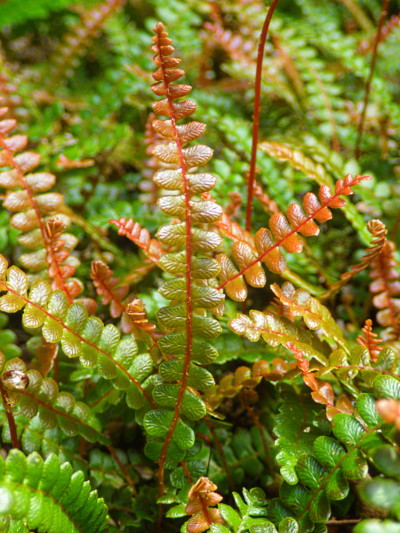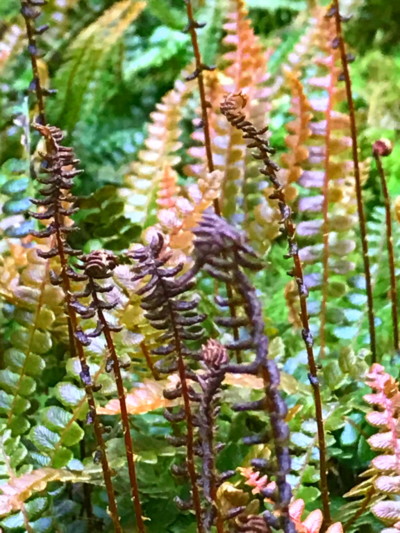Plant Life: Alpine Water Fern

New fronds display coppery red tips.
Small in Stature, Large in Impact
Ferns have a mystical or archaic quality about them. They bring to mind the age of dinosaurs or perhaps flights of fairies. And so ferns fit right into the primeval character of Bloedel Reserve’s Moss Garden.
Immediately upon entering the Moss Garden from the road, you will see on either side of the trail a diminutive little fern commonly called Alpine Water Fern or Antarctic Hard Fern. Officially it is known as Austroblechnum penna-marina, although most will know it under its now demoted genus Blechnum. Name changes are the nature of plant taxonomy and happen as a result of our increasing knowledge about how plants are related to each other. For example, the Deer Fern, formerly Blechnum spicant, is now in the genus Struthiopteris. Although related to the Deer Fern, the Alpine Water Fern actually hails from the southern hemisphere. Its native range is surprisingly large, including not only Chile and Argentina, but also Australia, New Zealand, and some Pacific islands.
Reds Among the Greens
At Bloedel Reserve, the Alpine Water Fern grows both in the Moss Garden and in the Japanese Garden where the ground is a little wet but not swampy. A good ground cover, it slowly spreads via its underground stems. Over the course of 20 years, it has slowly taken over an area that was first a formal lawn and then a moss lawn. Now that patch of ground is a swath of healthy evergreen fern fronds… and nobody seems to mind.

Fertile fronds are darker, skinnier and more upright than the sterile fronds.
Spring is when this fern really displays its garden merit. New fronds up to eight inches tall emerge. Tipped in coppery red, these new fronds stand out from the green moss all around them. Eventually the red fades towards a more normal green, but not before the fern sends up a second kind of frond. The red-tinged fronds are the “sterile” fronds, meaning they do not produce the spores that create new plants. After the sterile fronds have emerged, this fern produces very skinny, more upright “fertile” fronds that are easily distinguishable from the sterile fronds.
These fertile fronds produce spores but fortunately these spores do not seem to grow in our area. So new Alpine Water Fern plants have not popped up in unwanted locations at the Reserve. While this non-native fern is not a noxious weed, it can be mildly aggressive in gardens, albeit slow-growing. A little judicious annual weeding keeps it in its place.
— Content and photos courtesy Moss Garden Specialist Darren Strenge
SIGN UP FOR OUR ENEWSLETTER
Stay up to date on all of the events and activities taking place at Bloedel Reserve.

